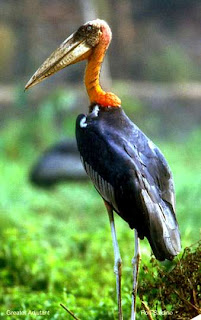Nombre científico: Leptoptilos dubius
Estado: amenazada, causas: destrucción del hábitat debido a la tala, el drenaje de humedales y el uso de plaguicidas.

En el mundo:
Asia: Bangladesh; Cambodia; India; Nepal; Tailandia; Viet Nam
Extinto en: Laos, Myanmar y Pakistan
Tamaño: 145 a 150cm
Hábitat: lagos, pantanos, ríos, charcos, humedales
Alimento: carroña, peces, ranas, reptiles, crustáceos, insectos grandes y patos
Parientes cercanos:
Marabú africano (Leptotilos crumenifer)
Fuentes:
http://www.birdlife.org/
http://www.arkive.org/
´
Imagen obtenida de:
www.kolkatabirds.com

I've been browsing online more than 3 hours today, yet I never found any interesting article
ResponderEliminarlike yours. It is pretty worth enough for me. In my opinion, if all website owners and bloggers made good content as you did, the web will be a
lot more useful than ever before.
Also visit my web-site - oliver-san.com
As I website possessor I believe the content material here
ResponderEliminaris rattling
fantastic , appreciate it for your efforts. You should keep it
up forever!
Best of luck.
My website :: golfpropertyspain.info
thank you very much, your comments encouraged me to keep working on the blog
ResponderEliminarmuchas gracias, su comentario me incentiva a seguir trabajando en el blog
Thank you, I have recently been searching for information about this
ResponderEliminarsubject for ages and yours is the best I have discovered so far.
But, what about the
bottom line? Are you sure about the source?
Also visit my web page Http://www.Illegalpropertyspain.com/
The end result is to describe as many species as possible with their connections in nature.
ResponderEliminarAnd people are going to be finding out what is happening with the animals around us (I get lots of comments from school children, their teachers who give homework over nature)
There are many sources that I have to check, especially the first to publish. But the vast majority are reliable websites are recognized for their work related to nature.
I browse through your website, I knew they are going through a major economic crisis, but did not know exactly what was happening with the properties, is very unfair.
I send greetings
Does your site have a contact page? I'm having a tough time locating it but, I'd like to
ResponderEliminarshoot you an e-mail. I've got some recommendations for your blog you
might be interested in hearing. Either way, great website and I look forward to seeing it
expand over time.
Feel free to surf my page ... www.marche-egalite.com
My email:
ResponderEliminarpakistamos@gmail.com